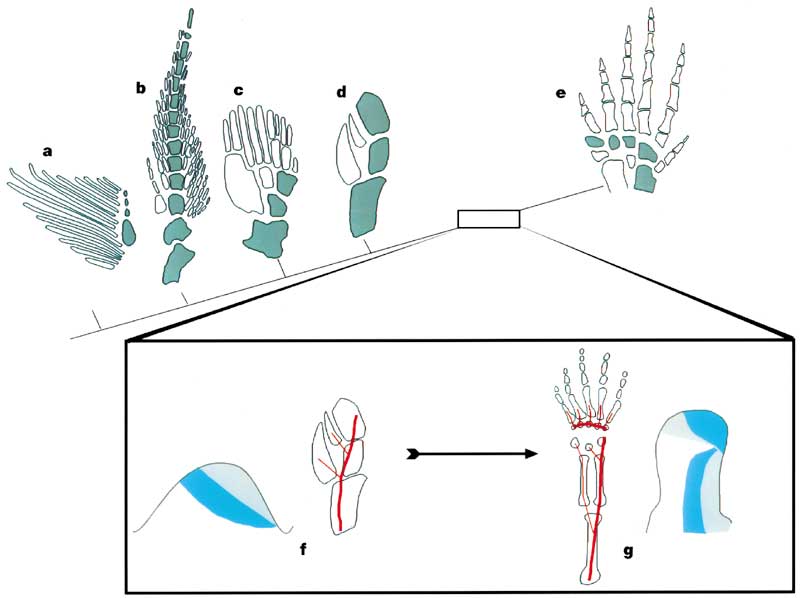
a figure from the essay
Fossils, Genes and the Evolution of Animal Limbs
by Neil Shubin, Clif Tabin and Sean Carroll
Figure 3 (from page 106 of Shaking the Tree: Readings from Nature in the History of Life edited by Henry Gee)
The origin of digits. A fin axis (shaded) is present in the fins of chondrichthyans (a, Cladoselache), basal actinopterygians (not shown), and sarcopterygians (b-e). In sarcopterygians such as Neoceratodus (b), Sauripteris (c), Panderichthys (d) and Tulerpeton (e), a single element (stylopod) articulates with the pectoral or pelvic girdle; all other proximal bones of the fin have been lost. The autopod is considered to be a synapomorphy of tetrapods because their nearest relatives do not have any apparent homologues of digits. Box: we propose that the origin of digits correlates with a novel pattern of Hox expression. f, The axis (thick line) of the fin of Panderichthys is short and radials (thin lines) branch preaxially. Patterns of phase II Hox expression (f; Hox D-11 in light shading, Hox D-13 in darker shading) were most likely already in place in sarcopterygian fins. g, The proximal portion of the axis (thick lines) of tetrapods compares with the entire axis of Panderichthys. Phase III Hox expression reflects a reversal of the nested domains of expression of Hox D-11 (g, light shading) and Hox D-13 (g, dark shading) during the time when the autopod is specified. This reversal in the polarity of Hox expression is considered to be correlated with the origin of the autopod; digits differ from more proximal structures in that they lie on the postaxial side of the axis. Because this hypothesis relies on genetic comparisons between phylogenetically disparate taxa (for example, teleosts and tetrapods), the shift from phase II to phase III collinear expression may have evolved in more basal sarcopterygians. Analogues of digits are seen in the fins of other sarcopterygian fish (c, Sauripteris); the expanded endoskeletons of rhizodontids include as many as eight branched preaxial radials. Different lineages of sarcopterygians appear to be inventing similar solutions to life in shallow freshwater ecosystems. The reconstruction of Tulerpeton (e) is modified from ref. 114.
Back to the list of color illustrations.
About the book: Shaking the Tree: Readings from Nature in the History of Life edited by Henry Gee, published by the University of Chicago Press.